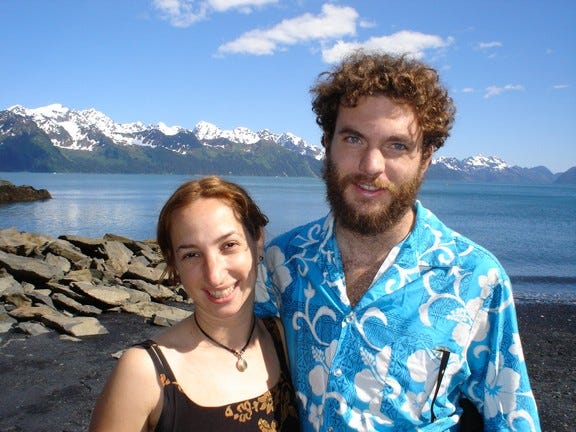Bad Ass Tumbleweeds
a lesson from invasive weeds
Once upon a time in my twenties, I was a bad ass bitch. I proclaimed it, I sang about it, I was resplendent with badassery. I was proud of my fierce independence. I needed no one. This was the 90s in New York and Seattle when combat boots weren’t just a fashion statement; they were about being ready for anything from a mosh pit to a riot to a protest to a quick escape up a mountain. I was inspired by contemporary music of other bad ass bitches like Ani Difranco, PJ Harvey, Alanis Morrisette, Lauryn Hill, Erykah Badu, Sinead O’Connor, Hole, Tori Amos, et al. I was pissed off at the injustice of the world like most people of my generation--alienated, under nurtured, irreverent youth. And as a woman, growing up in a time when sexual assault, domestic abuse and rape were still about blaming the victim for what she was wearing, being tough and invulnerable was almost a necessity.
And then, I moved to Alaska. I was always interested in living off-grid, inspired by my suburban New York childhood with my Back to the Land parents on an overgrown acre of land. When I learned that everyone rural lived off gird in Alaska, I thought that sounded like the coolest place in the world, and it was. I lived in a small close-knit community, chopping wood, carrying water, using an outhouse, and skiing out my front door. The enormity and vastness of the natural world in Alaska is already so humbling and add to that living at the mercy of the elements, and I began to soften a bit. Maybe that’s why when one day a friend pointed out to me that I was distant and always seemed angry, I was ready to hear it.
It's not easy to let go of the self-protective tools we have created
Recently I learned that Russian thistle grows where nothing else will. Maybe you heard of Russian thistle by it’s more common name, tumbleweed. It is an iconic staple of Western movies everywhere, rolling across a lone highway on its way to nowhere. When we moved to an off-grid home in New Mexico on a high mesa covered in sagebrush in 2020, much of it had already been cleared. When sagebrush is cleared, the only thing that can grow is tumbleweed.
Although there is an overgrowth of native sagebrush as a byproduct of historical overgrazing, it serves as shelter and shade for many animals such as sage sparrows, jackrabbits, rattlesnakes, deer mice, collard lizards, horny toads, coyote and more. It also helps other species of plants to grow like rabbit brush, sunflowers, milkvetch, evening primrose, toadflax, thymeleaf sandmat, globe mallow, salvia, daisies, paintbrush and more. Also, it smells amazing after the rain.
Tumbleweed on the other hand, is the worst. In the spring, you might be fooled into believing it is an innocent uptick of greenery, but it soon turns spiky and dries into a painful, thorny, and merciless plant that can disconnect from its roots to fly all over the place spreading its vicious seeds. Tumbleweed is my nemesis. I am at war with the tumbleweed, constantly yanking its baby shoots from my yard in the spring and raking the dry spiky rash-inducing barrels of thorns out of my yard as it gathers consistently along the outskirts of my fence in the fall.
Tumbleweed is a bad ass bitch. In some respects, I must give respect to this invasive plant that continues to thrive in conditions where no other can. It is extremely independent and does not rely on mycorrhizal networks. This is its power and its weakness. It is angry and mean and won’t let anyone get close.
That was my issue too in my younger years. Struggling with PTSD, PMDD, and undiagnosed ADHD, being a bad ass protected me for many years and hid my deeper insecurities. But it also kept me from being vulnerable with anyone or developing intimate relationships with healthy partners. My spiky veneer cloaked with general anger at the world and an aloof attitude alerted others to keep their distance. I avoided hurting my sensitive heart, but I also avoided nourishing my sensitive heart.
I learned recently that tumbleweed is good for the ecosystem. Since they don’t form mycorrhizal associations, fungal invasions will kill them off. In turn, the fungus population can increase and help more plants to grow. Also, dead tumbleweeds provide microshading for other sprouting plant species. Of course, the lone wolves must die before others may benefit. But in the long run, the barren ecosystem flourishes thanks to tumbleweed.
My bad ass bitch had to die too. Being spiky was hurtful to me and others. I had to let go of the prickly bitch and let others in. Through my Saturn return, my deepening yoga and meditation practice, as well as several winters in remote Alaska, I was able to let down my guard. Soon after, I met my husband, Eric, and we’ve been together for 20 years. I appreciate that person I used to be, holding compassion for my tumbleweed years and the lessons and nourishment they provided for who I am now.
Today, my land is home to a resurgence of heritage grasses. My yard is reminiscent of the desert grasslands this high mesa used to resemble before overgrazing and the excess of sage. I’m not sure what good fortune proliferated this turn of events. I created a moat around my house of gravel to protect my dog from the spiky burrs of tumbleweed, goat heads and horehound prolific in the high desert terrain. After three summers, grass began popping up through the landscape fabric below the gravel that creates a moisture layer with the caliche soil. Apparently, this was the required recipe. When I swing on my hammock, my fingertips graze the tall grass. Their seed tops swirl in the breeze with a soothing murmur. We are reseeding the high mesa. Once again, my fortifications have been transgressed and my life is better for it.






I love this so much!!!! Thanks, and you are still a badass!
I finally got permission to say I married a badass b****.